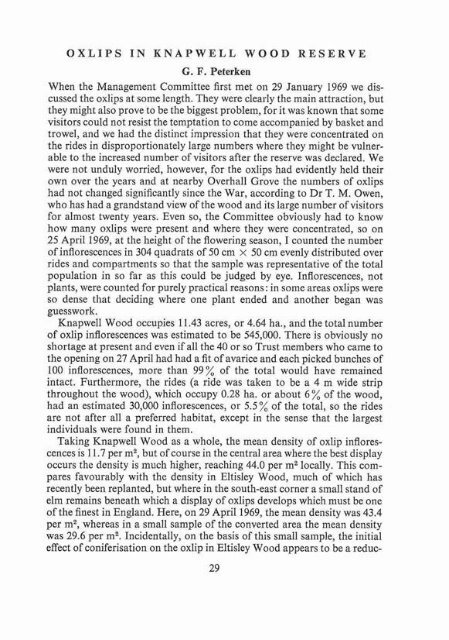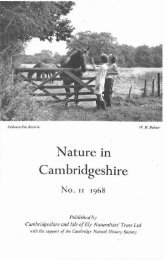Download PDF - Nature in Cambridgeshire
Download PDF - Nature in Cambridgeshire
Download PDF - Nature in Cambridgeshire
Create successful ePaper yourself
Turn your PDF publications into a flip-book with our unique Google optimized e-Paper software.
OXLIPS IN KNAPWELL WOOD RESERVEG. F. PeterkenWhen the Management Committee first met on 29 January 1969 we discussedthe oxlips at some length. They were clearly the ma<strong>in</strong> attraction, hutthey might also prove to be the biggest problem, for it was known that somevisitors could not resist the temptation to come accompanied by basket andtrowel, and we had the dist<strong>in</strong>ct impression that they were concentrated onthe rides <strong>in</strong> disproportionately large numbers where they might be vulnerableto the <strong>in</strong>creased number of visitors after the reserve was declared. Wewere not unduly worried, however, for the oxlips had evidently held theirown over the years and at nearby Overhall Grove the numbers of oxlipshad not changed significantly s<strong>in</strong>ce the War, accord<strong>in</strong>g to Dr T. M. Owen,who has had a grandstand view of the wood and its large number of visitorsfor almost twenty years. Even so, the Committee obviously had to knowhow many oxlips were present and where they were concentrated, so on25 April 1969, at the height of the flower<strong>in</strong>g season, I counted the numberof <strong>in</strong>florescences <strong>in</strong> 304 quadrats of 50 cm x 50 cm evenly distributed overrides and compartments so that the sample was representative of the totalpopulation <strong>in</strong> so far as this could be judged by eye. Inflorescences, notplants, were counted for purely practical reasons: <strong>in</strong> some areas oxlips wereso dense that decid<strong>in</strong>g where one plant ended and another began wasguesswork.Knapwell Wood occupies 11.43 acres, or 4.64 ha., and the total numberof oxlip <strong>in</strong>florescences was estimated to be 545,000. There is obviously noshortage at present and even if all the 40 or so Trust members who came tothe open<strong>in</strong>g on 27 April had had a fit of avarice and each picked bunclies of100 <strong>in</strong>florescences, more than 99% of the total would have rema<strong>in</strong>ed<strong>in</strong>tact. Furthermore, the rides (a ride was taken to be a 4 m wide stripthroughout the wood), which occupy 0.28 ha. or about 6 % of the wood,had an estimated 30,000 <strong>in</strong>florescences, or 5.5 % of the total, so the ridesare not after all a preferred habitat, except <strong>in</strong> the sense that the largest<strong>in</strong>dividuals were found <strong>in</strong> them.Tak<strong>in</strong>g Knapwell Wood as a whole, the mean density of oxlip <strong>in</strong>florescencesis 11.7 per ma, but of course <strong>in</strong> the central area where the best displayoccurs the density is much higher, reach<strong>in</strong>g 44.0 per ma locally. This comparesfavourably with the density <strong>in</strong> Eltisley Wood, much of which hasrecently been replanted, but where <strong>in</strong> the south-east corner a small stand ofelm rema<strong>in</strong>s beneath which a display of oxlips develops which must be oneof the f<strong>in</strong>est <strong>in</strong> England. Here, on 29 April 1969, the mean density was 43.4per mZ, whereas <strong>in</strong> a small sample of the converted area the mean densitywas 29.6 per mZ. Incidentally, on the basis of this small sample, the <strong>in</strong>itialeffect of coniferisation on the oxlip <strong>in</strong> Eltisley Wood appears to be a reduc-29



